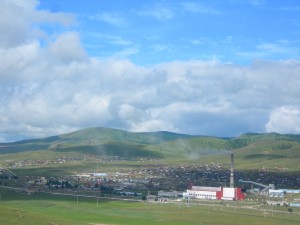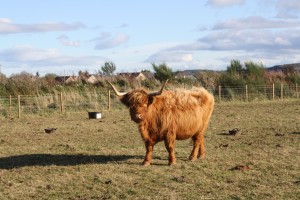As I started looking through literature on ways to reduce greenhouse gas emissions, it became clear that studies had approached the issue largely from two different angles: a) how specific industries are contributing to global warming in a broad sense, and b) how smaller-scale decisions, like those made by consumers, are involved. It made sense to continue this separation in my posts, so this week I’ll look at the larger-scale information, and in the final post of the month I’ll focus on things that I have considerably more control over, such as whether to get a hybrid for my next vehicle.
Fossil fuel use is the biggie, and, unfortunately, continuing to get bigger. According to Meinshausen et al. (2009), there was a 20% increase in CO² emissions from fossil fuel use between 2000 and 2006 alone (ouch!). When talking about stabilizing CO² concentrations in the atmosphere at low levels, van Vuuren et al. (2007) concluded that we’ve already passed or are close to passing those goals, so we would need to use an ‘over-shoot’ strategy in which we not only stop adding to the CO² in the atmosphere, but also start removing it. That seems like a tall order. What are our options for reducing emissions from fossil fuels? When we talk about fossil fuel use, we’re talking about energy production for the most part, whether that’s power to light our homes, power to run our cars, power for factories, or other uses. Not all fossil fuels are the same when it comes to emissions- natural gas, for example, burns cleaner than coal, so greater use of gas in power plants could be helpful toward our goals for emissions reduction; however, gas, like all fossil fuels is a limited resource and getting access to harder-to-reach deposits is a challenge which will continue to grow as we consume more accessible supplies. Fracking is one option for getting to smaller, scattered deposits, but around 5 million gallons of water are needed for each well’s fracking fluid (Black and Ladson 2012), and water is also becoming an ever-more precious resource.
Some have suggested biofuels as our best option for reducing our emissions since so much of what we do depends upon combustion. Not all biofuels are equal, however, nor is current production nearly enough to satisfy worldwide demand- according to Nash (2007), in 2007, even if all soybeans and corn grown in the US had been made into biofuel, it would only have provided 6 percent of the diesel and 12 percent of the gasoline needed. (And there is a HUGE debate raging over the ethics of using agricultural land for biofuel production when doing so will impact global food prices and/or cause much more land to be put into agricultural use thereby reducing other types of habitat [Nash 2007; van Blottnitz and Curran 2007; Borjesson 2009; ter Steege 2010].) When biofuel sources and processing methods are compared, some types seem to be better than others with regard to emissions. Sugar-based bio-ethanols, especially those using sugar cane, are more efficient at energy-conversion (van Blottnitz and Curran 2007) than other types of bio-ethanols. Biodiesel production has fewer emissions and greater energy return than bio-ethanol (Nash 2007). One of the biggest contributors to emissions during biofuel production is the energy source used for processing. In the US and most of northern Europe, coal and gas are used in biofuel plants (Borjesson 2009); in Sweden, however, the use of biomass as an energy source in grain-based bio-ethanol significantly reduced emissions. Emissions can be reduced even more if you piggy-back processes- for example, if there is a sugar-processing plant already in existence, and then you use the excess steam to power fermentation of the waste products, you are essentially producing bio-ethanol without additional emissions. And some promising research by David Tilman at the University of Minnesota suggests that native prairie grasses may be able to provide both efficient sources of cellulose ethanol and habitat for native species- that’s a pretty cool win-win if it can be implemented on a large scale.
What about emissions from agriculture in general? As I mentioned before, livestock husbandry is a source of methane, both from ruminants such as cows and manure in general. In 2006 Monteny et al. suggested that several options existed to reduce methane emissions, although some might be more practical than others: a) adding sugars and reducing fats in ruminant diets; b) giving dairy cows a longer lifespan so that a smaller proportion of their lives is spent in growth, when they produce methane but no milk; c) deep cooling of and frequent addition of straw to manure; and d) use of methane as a biogas through controlled storage of manure. Other agricultural activities, especially those that use machinery, contribute to greenhouse gas emissions; while cutting out machinery may not be an option, there are ways to counterbalance emissions: reduced-plowing or no-tillage practices help soil carbon stocks develop, removing CO² from the atmosphere; allowing un-used land to reforest also creates a CO² sink; and the development of reduced-emission products for agricultural use cuts back on CO² before it gets to the atmosphere (Adams et al. 1996).
All of the information above deals with systems-wide practices and options, which isn’t always applicable to our daily lives. I do, however, think it’s very important that we know how participation in these larger systems impacts greenhouse gas emissions. We may be able to make choices about where our power comes from, for example, selecting a biomass plant over a coal plant. We may also be able to push for changes in the way that biofuels are produced, and we can look for agricultural products that are produced with an eye to reduced emissions- maybe there is a dairy near you that uses methane as biogas- it might be worth becoming a customer to keep the system going.
It’s no good saying that these issues are much too big for us to influence- maybe change will be incremental, but it’s still change. However, I recognize that it’s affirming to see more immediate results from our actions, so next week I’ll look at smaller decisions we can make to reduce greenhouse gas emissions.
Works cited:
Adams, D.M., Alig, R.J., McCarl, B.A., Callaway, J.M. and S.M. Winnett. 1996. The forest and agricultural sector optimization model: model structure and applications. USDA FS Research Paper PNW-RP-495, Portland, Oregon.
Black, B. and M. Ladson. 2012. The legacy of extraction: reading patterns and ethics in Pennsylvania’s landscape of energy. Pennsylvania History 79: 377-394.
Borjesson, P. 2009. Good or bad bioethanol from a greenhouse gas perspective- what determines this? Applied Energy 86: 589-594.
Meinshausen, M., Meinshausen, N., Hare, W., Raper, S.C.B., Frieler, K., Knutti, R., Frame, D.J., and M.R. Allen. 2009. Greenhouse-gas emission targets from limiting global warming to 2° C. Nature 458: 1158-1163.
Monteny, G-J., Bannick, A. and D. Chadwick. 2006. Greenhouse gas abatement strategies for animal husbandry. Agriculture, Ecosystems and Environment 112: 163-170.
Nash, S. 2007. Decrypting biofuel scenarios. BioScience 57: 472-477.
ter Steege, H. 2010. Will tropical biodiversity survive our approach to global change? Biotropica 42: 561-562.
van Blottnitz, H. and M.A. Curran. 2007. A review of assessments conducted on bio-ethanol as a transportation fuel from a net energy, greenhouse gas, and environmental life cycle perspective. Journal of Cleaner Production 15: 607-619.
van Vuuren, D.P., den Elzen, M.G.J., Lucas, P.L., Eickhout, B., Strengers, B.J., van Ruijven, B., Wonink, S. and R. van Houdt. 2007. Stabilizing greenhouse gas concentrations at low levels: an assessment of reduction strategies and costs. Climatic Change 81: 119-159.


